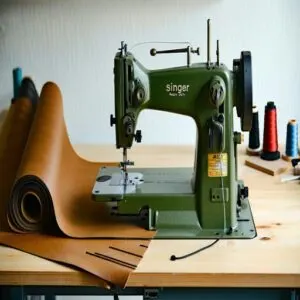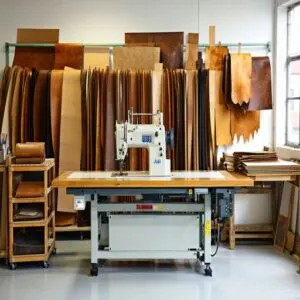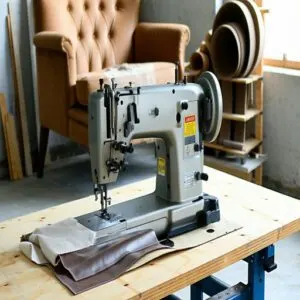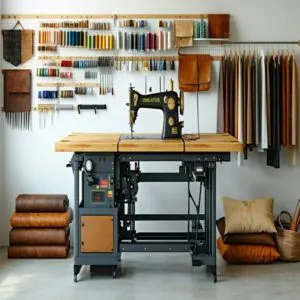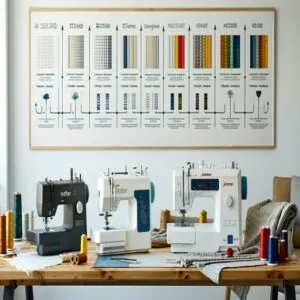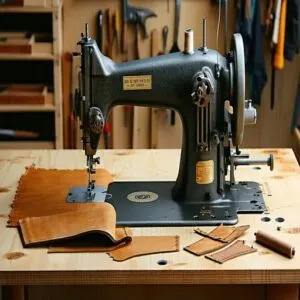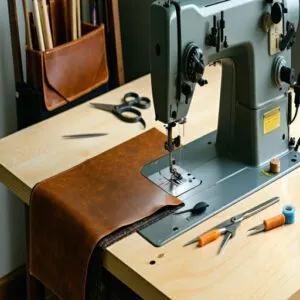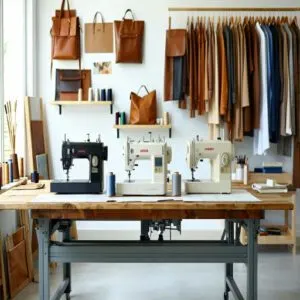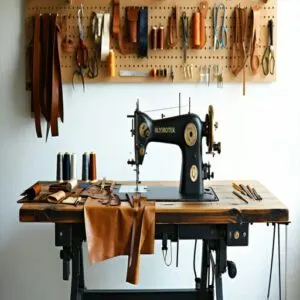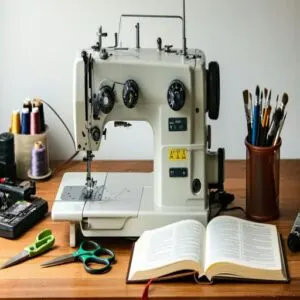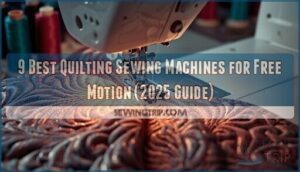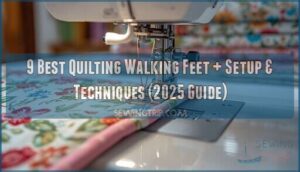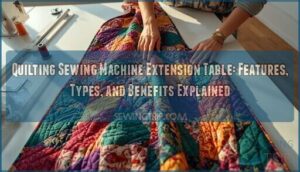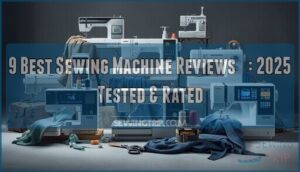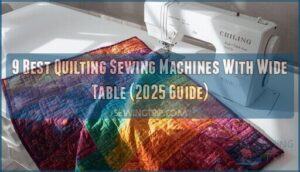This site is supported by our readers. We may earn a commission, at no cost to you, if you purchase through links.
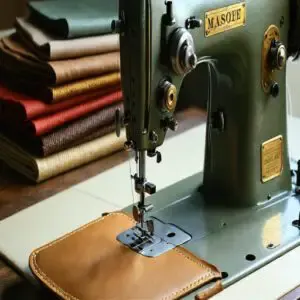
The Singer Heavy Duty 4432 is a reliable choice with 1,100 stitches per minute and a sturdy metal frame. For versatility, try the Brother ST150HDH, which handles multiple layers effortlessly.
If you’re tackling professional projects, the JUKI DU 1181N’s industrial build and top-and-bottom feed system are perfect. Upholstery machines like the Janome HD3000 or Juki DDL-8700H focus on speed and motor strength.
Prioritize features like adjustable foot pressure, and durable construction, and remember—your thread and needle matter just as much!
Table Of Contents
Key Takeaways
- Choose a heavy-duty machine like the Singer Heavy Duty 4432 or JUKI DU 1181N for sewing thick fabrics like leather and upholstery with ease.
- Look for features like adjustable foot pressure, a walking foot, and a top-and-bottom feed system for precise stitching on tough materials.
- Prioritize machines with a powerful motor and durable metal construction to handle heavy-duty projects without wear and tear.
- Test thread tension, use leather needles, and stick to longer stitches to avoid issues like skipped stitches and fabric damage.
Sewing Machine Types
In the context of sewing heavy fabrics like leather or upholstery, choosing the right type of machine makes all the difference.
You’ll find options like heavy-duty, industrial quilting, and top-and-bottom feed machines, each built to handle tough materials with ease.
Heavy-Duty Sewing Machines for Leather
If you’re tackling leather stitching, you need a heavy-duty machine built for the job.
These machines handle leather thickness, provide smooth sewing speed, and offer unmatched durability.
Techsew offers specialized leather sewing machines for heavy-duty projects.
- Singer Heavy Duty 4432 – Rugged and reliable for consistent results.
- Brother ST150HDH – A multitasking workhorse.
- JUKI DU 1181N – The industrial sewing machine leather enthusiasts love.
Industrial Quilting Machines for Leather
For leather quilting, industrial sewing machines like the Juki TL-2000Qi or Phaff 545 are unbeatable.
They bring machine speed, stitch control, and fabric handling to thick leathers effortlessly.
For those working with thinner leather, a best leather sewing machine may suffice.
Look for features like a servo motor, walking foot, and knee lift.
Thick leather? No problem!
| Machine | Stitch Speed | Key Feature | Max Stitch Length | Warranty |
|---|---|---|---|---|
| Juki TL-2000Qi | 1500 spm | Aluminum build | Adjustable (6 mm) | 5 years |
| Phaff 545 | Variable | Powerful servo motor | Adjustable | Available |
Industrial Top and Bottom Feed Sewing Machines
If you’re working with tough fabrics, an industrial sewing machine with a top and bottom feed system design is a lifesaver.
These heavy-duty sewing machines handle layered materials like leather and upholstery with ease.
The bottom feed mechanics guarantee precise stitching, while heavy-duty motors power through projects effortlessly.
It’s the best sewing machine for upholstery projects demanding durability and reliability.
Top 5 Leather Sewing Machines
If you’re tackling leather projects, you’ll need a sewing machine that can handle thick materials without missing a beat.
These top five leather sewing machines are tough, reliable, and built to keep your stitches smooth and strong.
1. Singer Heavy Duty 4432 Sewing Machine with Accessories
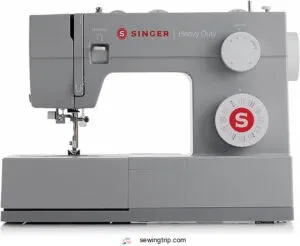
Ever wonder what makes a sewing machine truly heavy-duty?
The Singer Heavy Duty 4432 packs power and reliability for thick fabrics like leather.
With an impressive 1,100 stitches per minute and a rock-solid metal frame, it’s built to handle tough projects.
You’ll love its 32 built-in stitches and effortless needle threading, making sewing smooth and frustration-free.
The reverse stitch function guarantees strong, reinforced seams.
While it’s beginner-friendly, this workhorse delivers consistent results advanced sewers will appreciate.
Ready to tackle your next masterpiece?
Best For: Beginners and experienced sewers looking for a durable, high-speed machine capable of handling various fabrics, from delicate to heavy-duty materials.
- Handles thick fabrics like leather and denim with ease.
- High-speed stitching at 1,100 stitches per minute for efficient sewing.
- Durable metal frame ensures stability and longevity.
- Can develop oil buildup in gears over time without regular maintenance.
- Early servicing may be required with intense use.
- Limited stitch variety for highly complex sewing projects.
2. Brother ST150HDH Strong Tough Sewing Machine
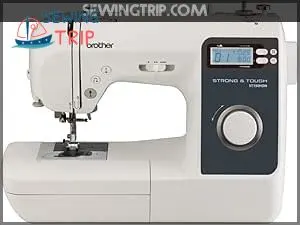
When you’re after a machine that’s tough yet beginner-friendly, the Brother ST150HDH sure stands out.
It handles heavy fabrics like a champ, including up to eight layers of canvas, thanks to its durable build.
With 50 built-in stitches and 9 included sewing feet, you’re set for creative freedom.
The LCD screen makes stitch selection easy, while its quiet motor won’t drive you crazy.
Sure, the LED light’s a bit dim, but you can work around that.
It’s a solid pick for versatile, heavy-duty projects.
Best For: Beginners or intermediate sewists looking for a durable machine capable of handling heavy fabrics and versatile sewing projects.
- Handles up to 8 layers of canvas with ease.
- Quiet operation with 50 built-in stitches for enhanced creativity.
- Includes 9 sewing feet and an easy-to-use LCD screen.
- Dim LED light requires additional lighting for better visibility.
- Lacks an automatic thread cutter, which can slow down workflow.
- Plastic throat plate may feel flimsy compared to metal options.
3. Singer 7258 Sewing and Quilting Machine for Beginners
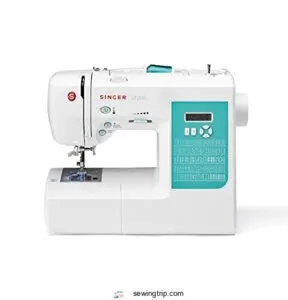
If you’re dipping your toes into sewing, the Singer 7258 is your new best friend.
With 100 stitch options, a programmable needle, and an easy-to-use automatic threader, it’s perfect for beginners keen to explore.
The heavy-duty metal frame keeps things steady, while the backlit LED screen makes stitch selection simple.
It’s great for fashion, quilting, or small leather projects, though the detachable bobbin cover can be annoying to keep track of.
For smooth stitches and stress-free sewing, this machine delivers beautifully.
Best For: Beginners and intermediate sewists looking for an easy-to-use, versatile sewing and quilting machine for fashion, home projects, and light leather or denim work.
- 100 stitch options with programmable needle for creative flexibility.
- Durable metal frame offers stability and smooth operation.
- Quiet and efficient for a variety of sewing projects, including quilting.
- Tedious stitch selection process can slow down workflow.
- No carrying case included for portability.
- Detachable bobbin cover is easy to misplace.
4. JUKI TL 2000Qi Sewing Quilting Machine
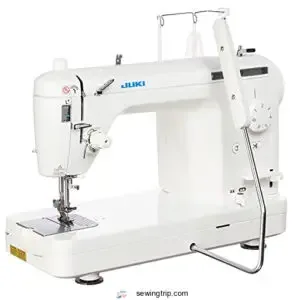
If you’re after precision and power, the JUKI TL-2000Qi is a straight-shooting workhorse.
With 1,500 stitches per minute, it’s perfect for quilting or heavy-duty sewing projects like leather.
The aluminum frame keeps vibrations low, while the automatic thread trimmer and knee lifter save time.
Sure, it’s pricey and only does straight stitches, but it’s built for quality, not frills.
The spacious workspace, bright LED lights, and reliable stitching make it a favorite for pros tackling big projects.
Best For: Advanced sewists and quilters looking for a heavy-duty, high-performance machine with precision and durability for straight stitching.
- High-speed stitching at 1,500 SPM for professional-grade sewing and quilting.
- Large work area and bright LED lights for tackling big projects with precision.
- Durable aluminum frame and automatic thread trimmer for low-vibration and efficiency.
- Only performs straight stitches, limiting versatility.
- Pricey at $1,499.00 USD, which may be a stretch for some budgets.
- Manual presser foot lift adds a bit of inconvenience.
5. JUKI DU 1181N Industrial Sewing Machine
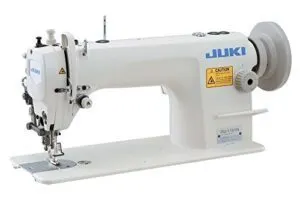
If you’ve got projects with medium-weight fabrics, the JUKI DU-1181N is like having a reliable co-worker.
Its top-and-bottom feed system keeps tricky materials steady, producing smooth stitches every time.
With speeds up to 2,000 stitches per minute and a 9mm stitch length, it handles jobs efficiently.
The built-in lubrication system saves you maintenance headaches, but assembly can be a puzzle without instructions.
While it’s not ideal for thick leather, it’s a powerhouse for lightweight leather and fabric-based tasks.
Best For: Small business owners, hobbyists, and crafters working with medium-weight fabrics and lightweight leather.
- Consistent stitch quality with top-and-bottom feed system.
- High-speed performance (up to 2,000 stitches per minute) for efficient sewing.
- Automatic lubrication for reduced maintenance effort.
- Assembly can be challenging due to lack of instructions.
- Not suited for heavy upholstery or thick leather materials.
- Minor blemishes or scratches possible during shipping.
Upholstery Sewing Machines
In the context of upholstery projects, you need a sewing machine that’s built for speed, strength, and precision.
These machines handle thick fabrics with ease, thanks to features like heavy-duty construction, powerful motors, and a walking foot.
Features to Consider for Upholstery Sewing Machines
When picking the best sewing machine for upholstery, focus on features that guarantee smooth fabric handling and precise stitch control.
Look for:
- Machine Speed: Faster speeds for heavy-duty projects.
- Motor Power: Reliable and durable for thick fabrics.
- Thread Tension: Adjustable for clean stitching.
- Durable Build: Heavy-duty materials for long-term use.
For additional product options, explore these best upholstery sewing machine resources.
Upholstery sewing demands strength and precision!
Number of Inbuilt Stitches for Upholstery
Choosing the best sewing machine upholstery projects depends on stitch variety.
Upholstery sewing needs often require flexibility to handle different fabric types and thread counts.
Machines like the Brother ST371HD or Janome HD3000 balance basic and decorative stitches well.
Here’s a quick look:
| Machine | Built-In Stitches | Speed (SPM) | Good For | Price Range |
|---|---|---|---|---|
| Brother ST371HD | 37 | 800 | Everyday Upholstery | Budget |
| Janome HD3000 | 18 | 860 | Heavy Duty Fabrics | Mid-Range |
| Singer Heavy Duty | 32 | 1100 | Fast Workflows | Affordable |
| Juki DDL-8700H | 1 (basic) | 5500 | Professional Use | High-End |
| Reliable Barracuda | 10 | 800 | Mobile Projects | Mid-Range |
Stitch variety lets you adapt for creativity, accuracy, and durability.
Keep your upholstery needs in mind!
Heavy-Duty Materials Used for Construction
You need a heavy-duty upholstery sewing machine built like a tank to handle tough jobs.
Look for metal frames paired with sturdy components—skip flimsy parts that can’t keep up.
Durable plastics and resilient mechanisms often mean your industrial sewing machine will last longer.
Strong builds, like Singer’s heavy duty sewing machines, guarantee smooth, frustration-free stitching for leather and upholstery projects, which can be considered a tough job.
Powerful Motor for Upholstery Sewing
A powerful motor is the heart of any heavy-duty upholstery sewing machine.
Look for motor efficiency and high torque output to handle thicker fabrics easily.
Speed control is key for precision, especially with intricate upholstery projects.
A good industrial sewing machine balances sewing performance with energy consumption, ensuring it’s reliable for long days, which boosts your sewing game effortlessly.
Walking Foot for Upholstery Sewing
If you’re after smoother upholstery stitching, a walking foot is your best friend.
It grips fabric layers evenly, preventing slips.
Sewing machine feet like this are a game-changer, especially for leather working.
The walking foot benefits every heavy-duty sewing machine for leather and upholstery projects, hands down.
Foot adjustment tips? Set it lightly for thinner fabrics, tighter for thick layers.
Sewing Machine Selection
Choosing the right sewing machine for leather and upholstery projects can feel overwhelming, but it doesn’t have to be.
Think about your project needs, machine durability, and features like motor strength and accessories to make the perfect pick.
Project Type and Machine Selection
Thinking about your next sewing adventure?
Whether you’re planning fabric-heavy upholstery projects or tackling leather crafting, matching your machine to your project’s complexity is key.
A heavy-duty sewing machine for leather and upholstery handles tough fabrics, while simpler models suit light tasks.
Balance sewing machine comparison and equipment choices to find the best sewing machine upholstery enthusiasts swear by.
Motor Reliability and Sewing Speed
When you’re sewing thick leather or upholstery, a reliable motor is your MVP.
Speed tests show servo motors excel, providing smooth sewing performance and ultra-quiet power output.
Need control? Servo motors allow precise adjustments for tricky bits.
For a detailed comparison of various motor types, explore this guide on comparing sewing machine motors.
Here’s why they shine:
- Motor Efficiency
- Energy Savings
- Adjustable Speeds
- Durable Build
- Reliability Factors
Machine Construction and Accessories
Strong metal frames and durable sewing motors are a must for handling leather and upholstery.
Look for machine tables that steady your work and accessories like bobbin cases, thread cutters, and leather sewing needles.
For specialized needs, consider exploring leather sewing machine accessories.
Reliable construction guarantees your heavy-duty sewing machine upholstery projects stay smooth.
Skim leather sewing machine reviews to find models with essential add-ons for long-term success.
Beginner-Friendly Vs Expert-Level Machines
Moving from accessories experience, let’s talk sewing skills.
Beginner machines, like the Brother ST150HDH, focus on stitch control and fabric handling, perfect for mastering basics.
Expert-level options, like the Juki TL-2000Qi, offer speed settings and precision, ideal for leather and upholstery work.
Leather sewing machine reviews often highlight these differences to help pick the best sewing machine for leatherwork.
Leather Sewing Techniques
Sewing leather takes a little extra care, but with the right techniques, it’s easier than you think.
Using the right needle, adjusting your presser foot, and choosing strong thread can make your stitches clean and professional.
Needle Selection for Leather Sewing
With leather, choosing the right needle is key to Sewing Precision.
Here’s what you need:
- Needle Types: Use a leather needle with sharp points like DI or Twist Point for clean Stitch Formation.
- Thread Selection: Match needle size to thread thickness for durability.
- Needle Durability: A sturdy needle prevents snapping, especially on thick leather.
Master these for seamless projects!
Foot Adjustment and Thread Type for Leather
Adjusting the foot pressure and picking the right leather thread makes sewing easier.
Use a Teflon or roller foot for smooth sliding over leather.
Nylon or polyester threads work best—skip cotton, it won’t last.
A thread conditioner can help prevent snags.
Here’s a quick guide:
| Adjustment | Purpose |
|---|---|
| Teflon Foot | Prevent sticking |
| Roller Foot | Smooth movement |
| Light Foot Pressure | Protect fabric |
| Nylon Thread | Durability |
| Thread Conditioner | Smooth stitching |
The provided guide offers solutions to common issues encountered when sewing leather, such as sticking and snagging, by adjusting the foot pressure, choosing the appropriate thread, and utilizing specific feet or conditioners.
Stitch Length and Error Prevention for Leather
Perfecting stitch length keeps your leather projects neat and durable.
For thicker pieces, aim for longer stitches—around 3.5-5mm—for better grip and Leather Stitch Control.
Manage sewing machine tension carefully to avoid puckering or skipped stitches.
A heavy-duty sewing machine for leather and upholstery guarantees smoother stitching, enhancing Leather Sewing Accuracy while reducing common errors, which is crucial for Leather projects to ensure durability.
Tips for Working With Leather
Before starting, prep your leather by marking cuts with a chalk pen—it’s gentler.
Use leather tools like a roller foot or walking foot on your sewing machine for leather; they give you steady stitches.
Choose polyester thread for durability, adjust tension, and sew slowly.
Leather sewing techniques like longer stitches prevent needle holes tearing the material.
For more in-depth guidance, explore these essential leather sewing tools and techniques.
Machine Maintenance
Taking care of your sewing machine keeps it running smoothly and helps avoid costly repairs.
With regular cleaning, lubrication, and simple checks like tightening screws, you’ll extend its life and keep your projects hassle-free.
Daily Cleaning and Lubrication for Sewing Machines
Keeping your leather sewing machine or heavy-duty machine in top shape takes just a little care.
Start with daily dust removal using cleaning tools, like a brush or cloth, and add machine oil or the right lubricant type to keep parts gliding smoothly.
Stick to maintenance schedules—it’s like feeding your machine its favorite snack for longevity and precise stitches!
Needle Replacement and Screw Tightening
Replacing needles and tightening screws keeps your leather sewing machine running smoothly.
Watch for screw looseness or needle wear to avoid thread breakage and ruin your project.
Proper sewing machine needle maintenance is essential for consistent stitching.
Here’s how to stay sharp:
- Replace needles after every project or signs of wear.
- Check for loose screws weekly.
- Follow maintenance schedules for machine calibration.
- Keep tools handy for quick adjustments.
This ensures your sewing machine is always in good working condition.
Covering and Storage for Sewing Machines
Protecting your sewing machine isn’t just smart—it’s a lifesaver for its lifespan.
Use machine covers, storage bags, or protective cases to shield from dust and dents.
Store machines securely to prevent accidents and guarantee equipment security.
| Storage Option | Benefit | Example Use |
|---|---|---|
| Machine Covers | Dust prevention | Home storage |
| Storage Bags | Portability | On-the-go projects |
| Protective Cases | Physical protection | Heavy-duty machines |
Treat your leather sewing machine like a prized tool!
Troubleshooting Common Sewing Machine Issues
Running into snags? Small machine errors can ruin your flow, but they’re often easy to fix.
- Thread Breakage: Check thread tension or a poorly threaded machine.
- Needle Damage: Replace bent needles—they’re common with heavy-duty sewing machine upholstery work.
- Motor Failure: Avoid overheating; take breaks.
- Tension Issues: Adjust settings slowly; test on scrap leather.
Stay patient—it’s part of mastering your craft!
Frequently Asked Questions (FAQs)
What is the best sewing machine for leather & upholstery projects?
Did you know upholstery machines can sew up to 5,500 stitches per minute?
For versatility and durability, the Juki DDL-8700 stands out with industrial power, smooth stitching, and a user-friendly design perfect for leather and upholstery.
How do I choose a heavy-duty sewing machine for leather?
Start with a strong motor and durable build—something that won’t “wobble” under pressure.
Look for adjustable stitch length, walking feet, and a versatile needle system to handle thick leather and upholstery fabrics smoothly.
Which sewing machine is best for leather?
Balancing durability and ease, the Juki TL-2010Q shines for leather with precision stitching and a powerful motor.
For beginners, the Brother ST150HDH offers simplicity and versatility, while pros love the speed of the Juki DDL-8700.
Which upholstery sewing machine should I buy?
You’ll love the Brother ST371HD for its versatility and ease or the Juki DDL-8700H for industrial strength and speed.
Want heavy-duty and reliable? Check out the Janome HD3000 or Reliable Barracuda 200ZW!
Can a sewing machine sew through leather?
Picture stitching a thick leather belt—yes, a sewing machine can handle it if it’s heavy-duty.
Look for sturdy machines with powerful motors, leather needles, and longer stitch lengths to glide through smoothly.
Can a sewing machine sew upholstery?
Absolutely, sewing machines can handle upholstery if they’re built for heavy-duty work.
Look for features like a strong motor, walking foot, and high-speed stitching.
A reliable machine transforms tough upholstery projects into a breeze!
What thread tension is best for leather sewing?
Set thread tension around 4-6 for most leather projects, but always test on scrap first.
Leather’s tricky, so fine-tuning might be needed depending on thickness.
Too tight? Threads snap. Too loose? Stitching looks sloppy.
How to avoid skipped stitches on heavy fabrics?
Skipped stitches happen when your needle isn’t sharp or tough enough.
Switch to a heavy-duty or leather needle, check your thread tension, and lengthen the stitch.
Also, don’t forget to slow down for control!
Can standard sewing machines handle upholstery projects?
Think a regular sewing machine can handle thick upholstery fabrics.
It’s possible for smaller projects, but you’ll need strong needles, longer stitches, and a heavy-duty machine if you’re tackling larger, tougher upholstery work.
What accessories improve performance on tough materials?
Invest in walking feet, Teflon feet, and leather needles—they’re game-changers.
Longer stitch lengths reduce strain, while polyester or nylon thread handles stress better.
Use beeswax for smoother sewing, and keep machine tension slightly higher for precision.
Conclusion
In the context of sewing leather and upholstery, don’t let the wrong machine throw a wrench in your plans.
Picking the right fit isn’t just about power—it’s about control and precision.
The Singer Heavy Duty 4432 or JUKI DU 1181N can easily handle those thick layers, while options like the Brother ST150HDH offer flexibility.
Remember, success with sewing machines for leather and upholstery often comes down to choosing tools that match your project’s needs.
Sew smart!
- https://sewcare.com/upholstery-sewing-machines/
- https://www.shelikestosew.com/best-sewing-machine-leather/
- https://www.reddit.com/r/Leathercraft/comments/10omlx1/what_is_a_good_sewing_machine_for_leather_that/
- https://www.seworbit.com/best-upholstery-sewing-machine-reviews/
- https://www.techsew.com/us/blog/how-to-pick-the-right-leather-sewing-machine.html

